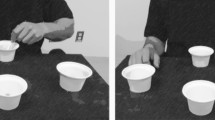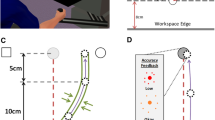Abstract
The aim of this study was to investigate age-related differences in dual task performance by using an upper limb proprioceptive task. Twenty-eight younger (18–30 years) and 28 older (>60 years) healthy adults performed circle tracing and serial subtraction tasks separately and concurrently. The tasks had two levels of difficulty: easy and hard. The circle tracing task included direct (easy) and indirect (hard) visual feedback conditions, and it was paired with serial subtraction by twos (easy) or threes (hard). We found that older adults were significantly slower than younger adults across all conditions and had significantly greater dual task costs when they performed circle tracing with easy serial subtraction. Higher levels of task difficulty were associated with slower speed in both groups. We found no age differences in accuracy. Participants either traded speed for accuracy or accuracy for speed regardless of age group. Overall, the findings suggest that speed and accuracy may be affected differently during dual tasking. In addition, older adults may rely more extensively on proprioceptive feedback to guide upper limb movement compared with younger adults.




Similar content being viewed by others
References
Hahn M, Wild-Wall N, Falkenstein M (2011) Age-related differences in performance and stimulus processing in dual task situation. Brain Res 1414:66–76
Lindenberger U, Marsiske M, Baltes PB (2000) Memorizing while walking: increase in dual-task costs from young adulthood to old age. Psychol Aging 15:417–436
Hollman JH, Kovash FM, Kubik JJ, Linbo RA (2007) Age-related differences in spatiotemporal markers of gait stability during dual task walking. Gait Posture 26:113–119
Huxhold O, Li S-C, Schmiedek F, Lindenberger U (2006) Dual-tasking postural control: aging and the effects of cognitive demand in conjunction with focus of attention. Brain Res Bull 69:294–305
Yogev-Seligmann G, Rotem-Galili Y, Mirelman A, Dickstein R, Giladi N, Hausdorff JM (2010) How does explicit prioritization alter walking during dual-task performance? Effects of age and sex on gait speed and variability. Phys Ther 90:177–186
Crossley M, Hiscock M (1992) Age-related differences in concurrent-task performance of normal adults: evidence for a decline in processing resources. Psychol Aging 7:499–506
Van Impe A, Coxon JP, Goble DJ, Wenderoth N, Swinnen SP (2011) Age-related changes in brain activation underlying single-and dual-task performance: visuomanual drawing and mental arithmetic. Neuropsychologia 49:2400–2409
Desrosiers J, Hébert R, Dutil E, Bravo G (1993) Development and reliability of an upper extremity function test for the elderly: the TEMPA. CJOT 60:9–16
Goble DJ, Coxon JP, Wenderoth N, Van Impe A, Swinnen SP (2009) Proprioceptive sensibility in the elderly: degeneration, functional consequences and plastic-adaptive processes. Neurosci Biobehav Rev 33:271–278
Kemper S, Herman RE, Lian CHT (2003) The costs of doing two things at once for young and older adults: talking while walking, finger tapping, and ignoring speech or noise. Psychol Aging 18:181–192
Kemper S, Schmalzried R, Herman R, Leedahl S, Mohankumar D (2009) The effects of aging and dual task demands on language production. Aging Neuropsychol Cogn 16:241–259
Verhaeghen P, Steitz DW, Sliwinski MJ, Cerella J (2003) Aging and dual-task performance: a meta-analysis. Psychol Aging 18:443–460
Hartley AA, Jonides J, Sylvester C-YC (2011) Dual-task processing in younger and older adults: similarities and differences revealed by fMRI. Brain Cogn 75:281–291
Heuninckx S, Wenderoth N, Swinnen SP (2008) Systems neuroplasticity in the aging brain: recruiting additional neural resources for successful motor performance in elderly persons. J Neurosci Methods 28:91–99
Vaportzis E, Georgiou-Karistianis N, Stout JC (2013) Dual task performance in normal aging: a comparison of choice reaction time tasks. PLoS ONE 8:e60265
Hartley AA, Little DM (1999) Age-related differences and similarities in dual-task interference. J Exp Psychol Gen 128:416–449
de Ribaupierre A, Ludwig C (2003) Age differences and divided attention: is there a general deficit? Exp Aging Res 29:79–105
Salthouse TA (1996) The processing-speed theory of adult age differences in cognition. Psychol Rev 103:403–428
Salthouse TA (1994) The aging of working memory. Neuropsychology 8:535–543
Hawkins HL, Kramer AF, Capaldi D (1992) Aging, exercise, and attention. Psychol Aging 7:643–653
Springer S, Giladi N, Peretz C, Yogev G, Simon ES, Hausdorff JM (2006) Dual-tasking effects on gait variability: the role of aging, falls, and executive function. Mov Disord 21:950–957
Hein G, Schubert T (2004) Aging and input processing in dual-task situations. Psychol Aging 19:416–432
Mutter SA, Goedert KM (1997) Frequency discrimination vs frequency estimation: adult age differences and the effect of divided attention. J Gerontol 52B:P319–P328
Cho C-Y, Gilchrist L, White S (2008) A comparison between young and old adults in their ability to rapidly sidestep during gait when attention is divided. Gerontology 54:120–127
Bherer L, Kramer AF, Peterson MS, Colcombe S, Erickson K, Becic E (2008) Transfer effects in task-set cost and dual-task cost after dual-task training in older and younger adults: further evidence for cognitive plasticity in attentional control in late adulthood. Exp Aging Res 34:188–219
Chen JY (2000) The effect of aging on dual-task performance: a meta-analysis of studies between 1981 and 1997. Brain Cogn 44:94–97
Bruyer R, Brysbaert M (2011) Combining speed and accuracy in cognitive psychology: is the inverse efficiency score (IES) a better dependent variable than the mean reaction time (RT) and the percentage of errors (PE)? Psychologica Belgica 51:5–13
Smith GA, Brewer N (1995) Slowness and age: speed–accuracy mechanisms. Psychol Aging 10:238–247
Wickens CD, McCarley JS (2008) Applied attention theory. Taylor & Francis, Boca Raton
Wickens CD (2002) Multiple resources and performance prediction. Theor Issues Ergonomics Sci 3:159–177
Blank A, Okamura AM, Kuchenbecker KJ (2010) Identifying the role of proprioception in upper-limb prosthesis control: studies on targeted motion. ACM Trans Appl Percept 7:23
Ferrell WR, Crighton A, Sturrock RD (1992) Age-dependent changes in position sense in human proximal interphalangeal joints. NeuroReport 3:259–261
Adamo DE, Martin BJ, Brown SH (2007) Age-related differences in upper limb proprioceptive acuity. Percept Mot Skills 104:1297–1309
McDowd JM, Craik FIM (1988) Effects of aging and task difficulty on divided attention performance. J Exp Psychol Hum Percept Perform 14:267–280
Say MJ, Jones R, Scahill RI et al (2011) Visuomotor integration deficits precede clinical onset in Huntington’s disease. Neuropsychologia 49:264–270
Kase SE, Ritter FE, Shoelles M (2006) Serial subtraction errors revealed. Proceedings of the 31th Annual Conference of the Cognitive Science Society. 1551–1556
Lemay M, Fimbel E, Beuter A, Chouinard S (2005) Sensorimotor mapping affects movement correction deficits in early Huntington’s disease. Exp Brain Res 165:454–460
Adamo DE, Alexander NB, Brown SH (2009) The influence of age and physical activity on upper limb proprioceptive ability. J Aging Phys Act 17:272–293
Ingram HA, van Donkelaar P, Cole J, Vercher J-L, Gauthier GM, Miall RC (2000) The role of proprioception and attention in a visuomotor adaptation task. Exp Brain Res 132:114–126
Nicolson RI, Fawcett AJ (1990) Automaticity: a new framework for dyslexia research? Cognition 35:159–182
Nasreddine ZS, Phillips NA, Bédiriam V et al (2005) The montreal cognitive assessment, MoCA: a brief screening tool for mild cognitive impairment. J Am Geriatr Soc 53:695–699
Wechsler D (2001) Wechsler test of adult reading. The Psychological Corporation, San Antonio
Rush AJ, Carmody T, Reimitz P-E (2006) The inventory of depressive symptomatology (IDS): clinician (IDS-C) and self-report (IDS-SR) ratings of depressive symptoms. Int J Methods Psychiatric Res 9:45–59
American Psychiatric Association (1994) Diagnostic and statistical manual of mental disorders, 4th edn. American Psychiatry Association, Washington
UNESCO (1997) International standard classification of education. Available at http://www.uis.unesco.org/ev.php?ID=7433_201&ID2=DO_TOPIC
Messier J, Kalaska JF (1997) Differential effect of task conditions on errors of direction and extent of reaching movements. Exp Brain Res 115:469–478
Goble DJ, Brown SH (2008) Upper limb asymmetries in the matching of proprioceptive versus visual targets. J Neurophysiol 99:3063–3074
Goble DJ, Coxon JP, Van Impe A, De Vos J, Wenderoth N, Swinnen SP (2010) The neural control of bimanual movements in the elderly: brain regions exhibiting age-related increases in activity, frequency-induced neural modulation, and task-specific compensatory recruitment. Hum Brain Mapp 31:1281–1295
Van Impe A, Coxon JP, Goble DJ, Wenderoth N, Swinnen SP (2009) Ipsilateral coordination at preferred rate: effects of age, body side and task complexity. Neuroimage 47:1854–1862
Cabeza R (2001) Cognitive neuroscience of aging: contributions of functional neuroimaging. Scand J Psychol 42:277–286
Grady CL (2008) Cognitive neuroscience of aging. Ann N Y Acad Sci 1124:127–144
Maquestiaux F, Lague-Beauvais M, Ruthruff E, Hartley A, Bherer L (2010) Learning to bypass the central bottleneck: declining automaticity with advancing age. Psychol Aging 25:177–192
Kahneman D (1973) Attention and effort. Prentice-Hall, New Jersey
Acknowledgments
Financial support for this study was obtained from the School of Psychology and Psychiatry, Monash University.
Conflict of interest
On behalf of all authors, the corresponding author states that there is no conflict of interest.
Author information
Authors and Affiliations
Corresponding author
Rights and permissions
About this article
Cite this article
Vaportzis, E., Georgiou-Karistianis, N. & Stout, J.C. Age and task difficulty differences in dual tasking using circle tracing and serial subtraction tasks. Aging Clin Exp Res 26, 201–211 (2014). https://doi.org/10.1007/s40520-013-0151-5
Received:
Accepted:
Published:
Issue Date:
DOI: https://doi.org/10.1007/s40520-013-0151-5




